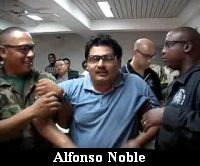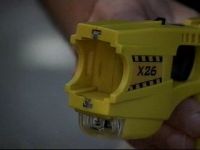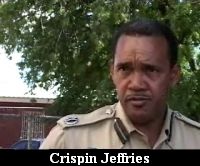 In the past, the police have been much criticized for using deadly
force in situations where it was unwarranted or unjustified. And while that's
fairly easy to judge form outside, for those in the moment of decision, it's
often kill or be killed. But does it have to be? Is there a middle ground between
a baton and a bullet? Well, there is now. The Police Department is introducing
the use of taser guns and today the media was witness to a high tech demonstration.
But for us, it brought back old memories.
[March, 2006]
Crispin  Jeffries to Alfonso Noble Jeffries to Alfonso Noble
"One of these days you know Noble. One of these days."
One of these days and today was that day, Alfonso Noble in Jeffries'
lair at the Raccoon Street Station strung up by BDF and Police and with Jeffries
supervising and apparently relishing the opportunity wired him up to settle
that old score with a taser. Of course, masochist that he is, Alfonso was smiling,
as he got ready for 50,000 volts of current sent coursing through his body –  in a one second burst of pure agony. in a one second burst of pure agony.
[Alfonso Tasered]
Question: How do you feel right now?
Alfonso Noble, Tasered
"Incapacitated."
While his incapacity was real it's only a demonstration of this taser
gun which will be employed by the Police Department. Alfonso volunteered, and
even signed a waiver. The man pulling the trigger was Mario Knapp, he is in
Belize as a company employed trainer. For the past two days he's been
lecturing 35 Police, Coast Guard and Customs Officers in the method of the Taser
Gun.
What makes it work are these two exposed electrodes which conduct and transmit
the electricity at extremely high voltage and very low amperage – a fraction  of the amperage in your wall outlet at home. of the amperage in your wall outlet at home.
It looks deadly, but it only momentarily disables the recipient basically by
confusing his or her nervous system and disabling their muscles. As Knapp demonstrated,
it works up to 21 feet, focusing with a pair of red lights firing a cartridge,
which embeds these two barbs in the subject. The barbs are attached to wires
that connect to the gun. It is meant to momentarily disable not to torture.
Mario Knapp, Trainer
"What that does in a nutshell is it locks the person up, they have
no control of their motor system so they end up falling and usually the injuries
are just that, falls to the elbow, the knee, and in some cases people have hit
their faces on the way down but those are the injuries associated with the taser
which are not related to the electricity."
ACP Crispin Jeffries, Commander of Operations
"As the records will show, it has very little impact on the heart
as well as any physical damage from the barbs if they penetrate the skin. The  Police Department has encountered a number of incidents where police officers
use lethal force resulting in the death of several persons over the last two
to three years. A decision was taken in 2007 and by mid 2008 we purchased a
shipment of tasers and that are presently in country to be used and deployed
nationally." Police Department has encountered a number of incidents where police officers
use lethal force resulting in the death of several persons over the last two
to three years. A decision was taken in 2007 and by mid 2008 we purchased a
shipment of tasers and that are presently in country to be used and deployed
nationally."
Jules Vasquez,
Mr. Jeffries can you name five current situations in which you would advocate
the use of tasers?
ACP Crispin Jeffries,
"I think there is the situation where we would have serious internal
riots inside the prison where it is a confined situation. There are cases where
we have violent male persons in domestic situations, there are violent mental
cases on the streets, and then we would have an unarmed situation where there
is a hostage with children in anywhere in Belize City. Those are the circumstances
where we would quickly think about.
Tasers will be deployed based on the department's needs and we would
deploy these tasers in limited cases to every head station until we acquire
the sufficient amount for us to have enough for all stations."
And while tasers will be a bold new means of stopping criminals, police also
have to be guarded against abuse of this device.
ACP Crispin Jeffries,
"The misuse of the taser, when it is not justified we will know when
it is deployed and we will look at the circumstances when it is used. The taser
has a built in information system that we can download and we can know when
it is deployed, how it is deployed, whether it was abused. However within the
Police Department's standard operating procedure there is a section of  the law under justifiable force which allows us to use force to subdue force
and if we see that it is better to use the taser rather than lethal force then
the taser will be deployed." the law under justifiable force which allows us to use force to subdue force
and if we see that it is better to use the taser rather than lethal force then
the taser will be deployed."
But beyond force, there is the threat of tasing, which is nothing nice and
it forces what is called voluntary compliance.
Mario Knapp,
"As a matter of fact some of the subjects on the streets if you ask
them they will tell you, the first thing they do is look on the Police Officer's
belt and see if there is a taser attached to it. The Department will employ
the taser and you will end up seeing about an 80% reduction rate for subjects
and for officers I believe some departments have reported even a 90% loss of
injuries to officers."
And while this red mark on his skin was the only evidence Alfonso had to show
for his small burst of pain, he says, he's not about to be tasered again.
Alfonso Noble,
"Well it is better than pepper spray, I can tell you that. It is a
debilitating experience, you feel like your muscles contract and you have no
control of your hands and your feet and you're just standing there and
you can't move. I can't say it hurts but it is an uncomfortable
feeling. It is not hurt per say but it is something you don't want to
feel again."
Jacqueline Godwin,
So this is something you see as being effective?
Alfonso Noble,
"Well definitely on me. I don't know if it would be effective
on other people but for sure I definitely don't want to feel that tase
ever again."
Commander of Police Operations Assistant Commissioner of Police Crispin
Jeffries told the media that he cannot comment on just how many tasers will
be issued and how much it will cost the Police Department but it is reported
that one such device can cost as much as eighteen hundred U.S. dollars. | 
